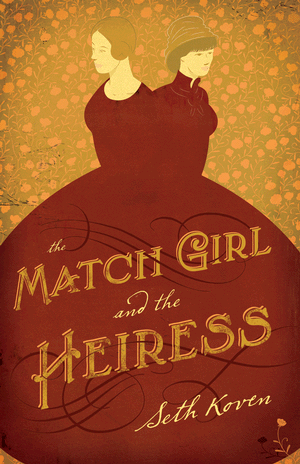
This is two books, interwoven. As its title indicates, The Match Girl and the Heiress is simply the story of two women who met and sustained a long, loving relationship. Together, they worked to improve their world. The author says it best: “This book is about Muriel and Nellie, the worlds of wealth and want into which they were born, the historical forces that brought them together, and the ‘New Jerusalem’ they tried to build in their London slum neighborhood of Bow.” At the same time, the author offers an extensive exposition of each assertion and a thorough and scholarly discussion of the social, economic, and political forces at work in their lives. Whether this interferes with the story or enhances it depends on the reader.
Nellie Dowell lived the poor and desperate life we’re all familiar with from Dickens’s novels. Muriel Lester was born to wealth. Neither married. Each was simultaneously typical and extraordinary. That is the kernel of the value of this book. The author explores just how this was the case.
The bare outlines are these. Nellie was born around 1876 and died, age 47, in 1923. Her family originally had modest means but was made destitute by the death of her father in 1881. He had worked in the merchant marine, rose to first mate, and died at sea. She and her sister were sent to state-run orphanages. She began work in a match box factory at age 12 and worked steadily until her health gave out. Muriel, who was born in 1885 to a large, wealthy middle-class family, died in her 80s. Her father was a self made, wealthy ship builder. She and her many siblings were nurtured, educated, and raised as earnest Baptists. She could have lived a life of ease but chose not to. It is not known when the two women met, but in 1915, amidst the horrors and dislocations of the World War, they founded Kingsley Hall in an abandoned Baptist chapel in East London. This was to be the living, concrete embodiment of their Christian idealism. This was to be the site of their shared life amid the confluence of the many social forces of the time.
The dates of their lives indicate the many forces that affected them, from the late Victorian into the twentieth century. The themes, each of them an important topic: capitalism, charity, wealth, poverty, views of childhood, Christian idealism, socialism, the norms of a hierarchical society, pacifism, the role of women, are described extensively.
Muriel’s life is more richly described but this is no reflection of bias or lack of interest in Nellie. It is simply an accurate reflection of her longevity and, because she was born to privilege, the range of choices that she was able to make. Her education and self-confidence armed her to write copiously, all her life. The one constant feature in her life was the impulse to improve the world. It would be easy to label her a life long “do-gooder,” but that would demean the virtue of her choices and the steadiness of her convictions. Whereas her quiet sister Doris was the one who often executed her wishes, the direction was Muriel’s. Her moral confidence came from her Christian belief, a lived and examined faith. It was not simply ceremonial, nor was it tolerant. Nellie’s options were to work hard, and, given her devotion to her family, the only legitimate choices were domestic or factory work. She worked in factories in London, in New Zealand and in Sweden, yet these choices were practical rather than adventurous. They worked together in Kingsley house, lived in adjoining houses in the Bow area of London, and shared a practical idealism. Muriel rose above the traditional role of the wealthy woman’s “lady bountiful.” Yet, in the author’s pithy comment “Nellie never confused reciprocity for equality.”
Both women had serious problems with ill health, and this is worth noting because these provided socially acceptable ways for them to express mutual devotion and offer physical care. From 1918, Nellie was a virtual invalid and Muriel worked on her campaigns alone. Illness, how it occurred, how it was treated, and where it was treated, offered another demonstration of the power of the class difference.
This is a scholar’s book that uses the device of a personal story as the means to discuss the many forces at play in British society. Generous and detailed references are offered to guide an interested reader to additional reading. There are many illustrations, appropriately places within the text, that give a sense of immediacy. This reader would have liked a time line with the key personal, social, and political events noted, since navigating the many developments, from the personal to the historical can be difficult without reference points. From the late Victorian era with its rising middle class, the forces of industrialization, the associated rise of socialism, and the struggle for women’s suffrage, all of these interacting with the aristocratic traditions of charity, patriotism, and colonialism, yielded a dense mix of forces. They were all felt and expressed in the lives of Nellie Dowell and Muriel Lester.
Related material
Bibliography
Koven, Seth. The Match Girl and the Heiress. Princeton: Princeton University Press, 2014. ISBN: 9780691158501. 464 pp.
Last modified 17 March 2015